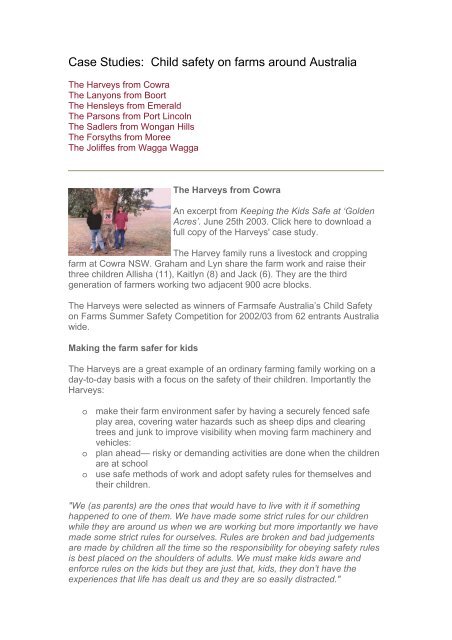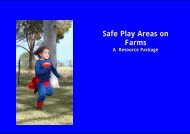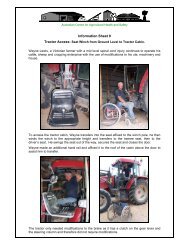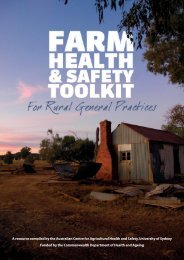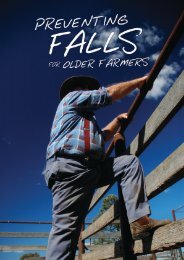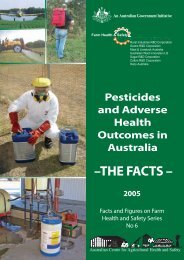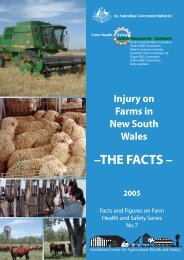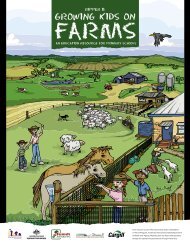Case studies on child safety from farms - Australian Centre for ...
Case studies on child safety from farms - Australian Centre for ...
Case studies on child safety from farms - Australian Centre for ...
Create successful ePaper yourself
Turn your PDF publications into a flip-book with our unique Google optimized e-Paper software.
<str<strong>on</strong>g>Case</str<strong>on</strong>g> Studies: Child <strong>safety</strong> <strong>on</strong> <strong>farms</strong> around AustraliaThe Harveys <strong>from</strong> CowraThe Lany<strong>on</strong>s <strong>from</strong> BoortThe Hensleys <strong>from</strong> EmeraldThe Pars<strong>on</strong>s <strong>from</strong> Port LincolnThe Sadlers <strong>from</strong> W<strong>on</strong>gan HillsThe Forsyths <strong>from</strong> MoreeThe Joliffes <strong>from</strong> Wagga WaggaThe Harveys <strong>from</strong> CowraAn excerpt <strong>from</strong> Keeping the Kids Safe at ‘GoldenAcres’. June 25th 2003. Click here to download afull copy of the Harveys' case study.The Harvey family runs a livestock and croppingfarm at Cowra NSW. Graham and Lyn share the farm work and raise theirthree <strong>child</strong>ren Allisha (11), Kaitlyn (8) and Jack (6). They are the thirdgenerati<strong>on</strong> of farmers working two adjacent 900 acre blocks.The Harveys were selected as winners of Farmsafe Australia’s Child Safety<strong>on</strong> Farms Summer Safety Competiti<strong>on</strong> <strong>for</strong> 2002/03 <strong>from</strong> 62 entrants Australiawide.Making the farm safer <strong>for</strong> kidsThe Harveys are a great example of an ordinary farming family working <strong>on</strong> aday-to-day basis with a focus <strong>on</strong> the <strong>safety</strong> of their <strong>child</strong>ren. Importantly theHarveys:o make their farm envir<strong>on</strong>ment safer by having a securely fenced safeplay area, covering water hazards such as sheep dips and clearingtrees and junk to improve visibility when moving farm machinery andvehicles:o plan ahead— risky or demanding activities are d<strong>on</strong>e when the <strong>child</strong>renare at schoolo use safe methods of work and adopt <strong>safety</strong> rules <strong>for</strong> themselves andtheir <strong>child</strong>ren."We (as parents) are the <strong>on</strong>es that would have to live with it if somethinghappened to <strong>on</strong>e of them. We have made some strict rules <strong>for</strong> our <strong>child</strong>renwhile they are around us when we are working but more importantly we havemade some strict rules <strong>for</strong> ourselves. Rules are broken and bad judgementsare made by <strong>child</strong>ren all the time so the resp<strong>on</strong>sibility <strong>for</strong> obeying <strong>safety</strong> rulesis best placed <strong>on</strong> the shoulders of adults. We must make kids aware anden<strong>for</strong>ce rules <strong>on</strong> the kids but they are just that, kids, they d<strong>on</strong>’t have theexperiences that life has dealt us and they are so easily distracted."
The Lany<strong>on</strong>s <strong>from</strong> BoortA Superb Safe Play Area at Boort, VictoriaRoslyn and Isaac Lany<strong>on</strong> and their <strong>child</strong>renBrydie(8), Otis(6) and Tillie-Mae(4) are the winnersof the Victorian award presented at VictoriaFarmsafe Forum by Paul Weller President of theVictorian Farmers' Federati<strong>on</strong>.The Lany<strong>on</strong>'s live <strong>on</strong> a 400 hectare cropping and sheep property near thetown of Boort in the north of Victoria. Isaac is a third generati<strong>on</strong> farmer.Their key strategies <strong>for</strong> keeping their <strong>child</strong>ren safe <strong>on</strong> the farm are:• supervisi<strong>on</strong> - <strong>on</strong>e of the key reas<strong>on</strong>s <strong>for</strong> Roslyn's decisi<strong>on</strong> to stay athome as a full-time Mum, farm office worker and farm assistant; and• a safe play area has been c<strong>on</strong>structed to <strong>for</strong>m a barrier between the<strong>child</strong>ren and farm hazards.Safety has always been an important c<strong>on</strong>siderati<strong>on</strong> and incidents at homeand locally have rein<strong>for</strong>ced the need <strong>for</strong> acti<strong>on</strong>."we have been slack <strong>on</strong> the seatbelt rule in the ute around the farm. Therewas a tragedy recently involving a local family where there was a lack ofseatbelts. This has really shocked every<strong>on</strong>e into line - and seatbelts are now<strong>on</strong> - always! And we never let the kids <strong>on</strong> the back of the ute. They alwaysnag, but we never give in!"The farm includes a dangerous irrigati<strong>on</strong> channel close to the house."We d<strong>on</strong>'t tell the kids that there are crocodiles in the water, we tell them thatthey can drown. We read them stories out of the paper that remind them whatcan happen <strong>on</strong> <strong>farms</strong>."Roslyn believes that an interesting outside envir<strong>on</strong>ment is vital to keeping<strong>child</strong>ren within 'safe' areas.Some of the key features of their w<strong>on</strong>derful safe play area include:• A 1.2 metre fence c<strong>on</strong>structed <strong>from</strong> wire mesh with improvised selflatching gates. "I have yet to see a <strong>child</strong> successfully climb it. Mostpeople have house yards, but many are inadequately fenced if they areintended to keep the kids inside."• The area can be visually patrolled <strong>from</strong> the kitchen and office and is anadequate distance <strong>from</strong> the workshop and machinery shed.• The play area is large (23m by 27m) with age-specific play equipmentand activities including: a trampoline at ground level (built above a pit);a cubby <strong>on</strong> several levels, but with ladders which can be removed
depending <strong>on</strong> the age of visiting <strong>child</strong>ren; a completely shaded sand pitand an expanse of open lawn; in summer a shallow wading pool isplaced under a shady tree and is <strong>on</strong>ly used <strong>for</strong> "buddy" swimming andunder supervisi<strong>on</strong>; a thoughtful selecti<strong>on</strong> of plants (<strong>for</strong> smell andeating), places <strong>for</strong> the <strong>child</strong>ren to sit and paths that take them throughinteresting spaces; the play area can be partiti<strong>on</strong>ed <strong>from</strong> the rest of thehouse yard and temporary fences and gates have been used at timesto keep little <strong>child</strong>ren in the correct areas. As the <strong>child</strong>ren get older andtheir play interests change, they play in other areas of the yard.• During school holidays Roslyn and the <strong>child</strong>ren and plan special themedays, interesting activities and family outings.Roslyn's primary teaching background means that she takes into account<strong>child</strong>ren's developmental characteristics when deciding what to allow them todo:"We d<strong>on</strong>'t let our <strong>child</strong>ren <strong>on</strong> motorbikes. I'm a bike educati<strong>on</strong> teacher and Iknow their limitati<strong>on</strong>s … tunnel visi<strong>on</strong> <strong>for</strong> example. Children are unpredictable,and like to push the boundaries as much as possible. Our farm is not perfectby any means and there may be many things we have 'got wr<strong>on</strong>g,' but <strong>on</strong>lyfurther educati<strong>on</strong> will help us. We are probably 'over safe' at times, especiallywith visitors - but you can never be too careful."The Hensleys <strong>from</strong> EmeraldQueensland Cattle Farmer Highlights Changing Natureof Child SafetyNina and Chris Hensley and their <strong>child</strong>ren, Adam(2)and Ivy(4) were announced as the Queensland Statewinner of the Child Safety <strong>on</strong> Farms Competiti<strong>on</strong> inEmerald at the Country Women's Associati<strong>on</strong> by AlanJacks<strong>on</strong> Area Manager of Farmsafe QLD.The Hensley's live <strong>on</strong> a 100,000 acre property about anhour <strong>from</strong> Emerald in Western Queensland where theyrun 5000 cattle. In accepting the award Nina Hensleynoted that she did not originally come <strong>from</strong> a ruralbackground and there<strong>for</strong>e sees different hazards <strong>from</strong>her partner."I am particularly c<strong>on</strong>cerned about water hazards, agricultural chemicals andpois<strong>on</strong>ous plants. My husband is more aware of dangers surrounding farmmachinery and stock. Together I hope we provide a safe envir<strong>on</strong>ment <strong>for</strong> our<strong>child</strong>ren which doesn't hinder their natural curiosity and development."Sometimes this can create difficulties in getting things d<strong>on</strong>e. For exampleNina was <strong>on</strong>ly successful in having the fence around the house yard fixed
when she let Chris to look after the kids <strong>on</strong>e daywith firm instructi<strong>on</strong>s that theyweren't to go near the shed. "The next day our yard was made secure."Both Nina and Chris believe that creating exclusive "out of bounds" areafeeds curiosity. They see supervised explorati<strong>on</strong> as a way of removing themystery and the likelihood that their <strong>child</strong>ren will sneak away to explore theseareas <strong>on</strong> their own.Nina believes that the most under-rated danger <strong>on</strong> <strong>farms</strong> is horses. "Even aquiet horse can get a fright and behave unpredictably and I would dearly loveto see all farm <strong>child</strong>ren wear head protecti<strong>on</strong>. Chris and I agree that we w<strong>on</strong>'thave a p<strong>on</strong>y <strong>on</strong> 'Peakvale. When our <strong>child</strong>ren are old enough to manage astockhorse, <strong>on</strong>ly then are they are old enough to learn to ride. Till then, weoccasi<strong>on</strong>ally lead them around <strong>on</strong> a horse."Significantly, the Hensleys recognise that <strong>child</strong> <strong>safety</strong> has to be c<strong>on</strong>tinuallymanaged: "It doesn't matter how many <strong>safety</strong> strategies are put in place, thereis always another area that can be addressed as <strong>child</strong>ren's capabilities andinterests are c<strong>on</strong>stantly changing. What was safe <strong>on</strong>e year may not be thenext and having completed Farmsafe Australia's checklist <strong>on</strong>ce is no excuse<strong>for</strong> not doing it again. All in all though, there is absolutely no substituti<strong>on</strong> <strong>for</strong>adequate supervisi<strong>on</strong>."The Pars<strong>on</strong>s <strong>from</strong> Port LincolnSA Farmer Steers Clear of Dangerous EquipmentRob Pars<strong>on</strong>s is a fourth generati<strong>on</strong> farmer <strong>on</strong> his1000 hectare farm 50Kms north of Port Lincoln inSA's Ayre Peninsula. He and his wife Sue (whoworks as a nurse) have brought up their two<strong>child</strong>ren <strong>on</strong> the farm - Daniel (now 19) and Rachel(now 16) and c<strong>on</strong>tinue to have <strong>child</strong>ren regularlyvisit with them <strong>on</strong> the farm.The presentati<strong>on</strong> to Rob took place at the SAFarmers Federati<strong>on</strong> Annual Dinner held duringFarm Safety week. John Ruskin, CEO of <strong>Australian</strong>Primary Superannuati<strong>on</strong>, presented the award atthe dinner to Peter Treloar, a friend and neighbour, who was representingRob. Peter acknowledged the work and <strong>safety</strong> ethic that the Pars<strong>on</strong>s have <strong>on</strong>their property.Rob's focus <strong>on</strong> <strong>safety</strong> stems <strong>from</strong> his father who got caught in the PTO of aheader. His father used to always bring it up and show them pictures andmake them think about what could have happened.
"He survived. The PTO tore off all his clothes. He was left standing in hisshoes and socks .. the <strong>on</strong>ly mark <strong>on</strong> him was where his leather belt screwedinto a knot at his back be<strong>for</strong>e it <strong>for</strong>tunately broke. The thought of what mighthave happened leaves a nasty taste in your mouth."Risks <strong>on</strong> the farm that the Pars<strong>on</strong>s have had to manage include water,chemicals and heavy machinery. "We have lots of dams including <strong>on</strong>e rightnext to the house. The kids are amazed that there are crocs here in SA …there's even a sign up which warns them."As well as this "psychological" measure they also have fenced barriers."We have two cycl<strong>on</strong>e fences around the dam. The outer <strong>on</strong>e is the fence ofthe house yard and then there is a lane way between it and the sec<strong>on</strong>d <strong>on</strong>ewhich is of smaller squares. If they make it through the first the sec<strong>on</strong>d <strong>on</strong>egenerally puts them off. Other water hazards such as troughs and dips wekeep covered."Motorbikes aren't used <strong>on</strong> the farm as Rob believes they are too dangerous.He uses raceways and a 4 wheel drive utility to manage the movement ofsheep. "Most of the other farmers around here have 4-wheel motorcycles but Ihaven't allowed myself to go that way."According to Rob a major c<strong>on</strong>tributor to the issue of <strong>child</strong> <strong>safety</strong> is thatfarmers are stretched and sometimes have little choice but to take their<strong>child</strong>ren with them when they are working. "I have a real problem with kidsgoing <strong>on</strong> tractors and headers. But it's happening because of there's no <strong>on</strong>eelse to look after the kids. The kids go to sleep after a couple of roundsbecause of the heat and they can so easily hit a butt<strong>on</strong> or the door handle …and they can pop open so easily."The Sadlers <strong>from</strong> W<strong>on</strong>gan HillsWA Winners - L<strong>on</strong>g Time Supporters of Child SafetyChristine and D<strong>on</strong> Sadler <strong>from</strong> W<strong>on</strong>gan Hills are theWA State winners of the <strong>child</strong> <strong>safety</strong> <strong>on</strong> <strong>farms</strong>competiti<strong>on</strong>. The presentati<strong>on</strong> of the award was madeas part of Farmsafe Week by Dr Graeme Roberts<strong>on</strong>,Director General of the Department of Agriculture.Christine and D<strong>on</strong> have brought up four <strong>child</strong>ren <strong>on</strong>their wheat and sheep (6000 head) farm and nowhave family, friends and occasi<strong>on</strong>ally tourists who visitthe farm with <strong>child</strong>ren.The Country Women's Associati<strong>on</strong> was the beginning of Christine's interest infarm <strong>safety</strong>. "Stories come through in meetings … and the statistics arehorrifying. We also have had some bad accidents around here … <strong>on</strong>e of ourneighbours lost an arm."
These accidents made the Sadlers aware of just how important the issue wasand how people in the regi<strong>on</strong> needed c<strong>on</strong>stant reminding because it was soeasy to lapse into a false sense of security.Christine has been a guest speaker at schools in the district and has placedstories in the local papers about accidents and near accidents. She believesthat reading about other people's accidents is the best way to get themessage through <strong>on</strong> farm <strong>safety</strong>.Farmsafe crosswords, puzzles and poems were used to promote farm <strong>safety</strong>in the media. Christine has adhered hundreds of farm safe stickers <strong>on</strong> to utesand other machinery and given out thousands of pamphlets <strong>on</strong> <strong>safety</strong> at fielddays, clearing sales and the local footy!Christine subsequently started a Careful Cocky column in the local FarmWeekly that has been going now <strong>for</strong> five to six years. She still c<strong>on</strong>tributes to itoccasi<strong>on</strong>ally but it is now self sustaining. There are many steps that theSaddlers have taken to make their farm safer <strong>for</strong> kids. These includerestricting play to near the house, making dams and old wellsinaccessible andprohibiting travel <strong>on</strong> the backs of utes."The houses are properly fenced off and we have never allowed the kidsaround machinery or <strong>on</strong> motor bikes. D<strong>on</strong> wouldn't let the kids ride amotorbike until they were old enough to be able to pick it up and they alwayshad to wear a helmet. D<strong>on</strong> always wears a helmet and goggles <strong>on</strong> the biketoo."Christine and D<strong>on</strong>'s s<strong>on</strong> Darren is now helping to run the farm and <strong>safety</strong>measures are still being implemented. Most recently new <strong>safety</strong> ladders wereinstalled <strong>on</strong> 12 silos <strong>on</strong> the property. Safety rails near the shearing shed stepswere installed and the workshop is now lockable.Christine also believes that farm women play a vital role in farm <strong>safety</strong>:"If a woman chooses to help run the farm, her role can be paramount inc<strong>on</strong>tributing to farm <strong>safety</strong> around the home and workplace. It is a full timerewarding and stimulating job being in the home <strong>on</strong> a farm, and c<strong>on</strong>tributing ina worthwhile way to everything happening around you. I think farm <strong>safety</strong> is atrisk when there is not that extra pers<strong>on</strong> (especially the female aspect) to addideas and comments to discussi<strong>on</strong>s <strong>on</strong> farm <strong>safety</strong>."Next page
The Forsyths <strong>from</strong> MoreeAs a toddler, growing up <strong>on</strong> or even visiting a farm orrural property can be an exciting and happyexperience. There are so many things to see anddo. There are wide open spaces you want toexplore. There are dams; trucks; tractors & animals,just like the toy farm set, right out there in thepaddock. And they’re bigger – and they move too.Anything that’s big and moves looks really interestingwhen you’re little. Raising <strong>child</strong>ren <strong>on</strong> <strong>farms</strong> or ruralproperties can be an exciting and happy experiencetoo. But it can also be a challenge - weighing up thedesire to provide a unique and stimulatingexperience <strong>for</strong> your <strong>child</strong>; against the need to keepthem safe in an envir<strong>on</strong>ment with many more hazards than the averagesuburban backyard.Wendy Forsyth knows these challenges too well. Wendy, her husband Johnand 18 m<strong>on</strong>th old William live <strong>on</strong> ‘Gabo’, a cattle/grains property innorthwestern NSW. “William just loves the tractors,” says Wendy, as Williamexcitedly gabbles “…tacta, tacta…”. As we walk past the shed, William runstoward the grain harvester, currently stored out of seas<strong>on</strong>. John has recentlyraised the access ladder, out of reach of small climbersWilliam also loves water.& The dam is about 200 metres <strong>from</strong> the house – stillwalking distance <strong>for</strong> an adventurous and determined toddler. There’ssomething about the sparkle and movement of water that attracts youngstersall too easily. Dams, rivers, troughs, irrigati<strong>on</strong> channels and tanks arecomm<strong>on</strong> drowning hazards present <strong>on</strong> <strong>farms</strong>.“John thinks it’s better to avoid taking William near the dam when we’re outand about <strong>on</strong> the farm – that way he may be less likely to want to go there, ifhe ‘escapes’”, says Wendy. Even if able to swim, young <strong>child</strong>ren easily toppleover into water and are not str<strong>on</strong>g enough to climb out of the muddy andsometimes steep embankments of dams, creeks and channels.“Approximately 30 <strong>child</strong>ren die each year <strong>on</strong> <strong>Australian</strong> <strong>farms</strong>, with up to 600injured seriously enough to require admissi<strong>on</strong> to hospital <strong>for</strong> farm-relatedinjuries,” says Mr. Laurie Stiller, Program Leader <strong>for</strong> the Child Safety <strong>on</strong>Farms Strategy, Farmsafe Australia.Many more <strong>child</strong>ren present to general practiti<strong>on</strong>ers and emergencydepartments of country hospitals. According to research carried out by the<strong>Australian</strong> <strong>Centre</strong> <strong>for</strong> Agricultural Health & Safety, drowning and vehiclerunovers are the main causes of death and serious injury <strong>for</strong> the 0-5 year agegroup <strong>on</strong> <strong>farms</strong>.C<strong>on</strong>cern over the high rate of <strong>child</strong> injury <strong>on</strong> <strong>farms</strong>, led Farmsafe Australia todevelop a program to address the issue. The Program was launched in
December 2002 by H<strong>on</strong>. Larry Anth<strong>on</strong>y, Federal Minister <strong>for</strong> Children & YouthAffairs. It encompasses research into injury, effective soluti<strong>on</strong>s, developmentof educati<strong>on</strong> resources and promoti<strong>on</strong> of key <strong>child</strong> injury preventi<strong>on</strong> strategies.A Child Safety <strong>on</strong> Farms Checklist, factsheets and guidance booklet are someof the resources available to assist farm families to address <strong>child</strong> <strong>safety</strong>hazards <strong>on</strong> the farm. One of the key recommendati<strong>on</strong>s of the program is thecreati<strong>on</strong> of “safe play areas” <strong>for</strong> small <strong>child</strong>ren <strong>on</strong> <strong>farms</strong>.“The idea of a “Safe Play Area” – whether it be the house yard, or an areadown near the dairy, is simply about c<strong>on</strong>structing an area which securelyseparates very young <strong>child</strong>ren <strong>from</strong> farm hazards such as water, vehicles,machinery, motorbikes or animals,” says Mr. Stiller.“Safe play areas need to be securely fenced, located where <strong>child</strong>ren arehighly visible and ideally have plenty of shade and interesting activities <strong>for</strong>young <strong>child</strong>ren, such as sandpits, play-equipment etc.” Mr. Stiller said.Wendy and John have a safe play area <strong>on</strong> their farm.“I can usually see William playing in the yard <strong>from</strong> the <strong>from</strong> the laundry. I stillkeep a close eye <strong>on</strong> him, but he is generally safe inside the yard. If it goesquiet, I know to check around the fr<strong>on</strong>t of the yard or check that the gatehasn’t been left open – it <strong>on</strong>ly takes <strong>on</strong>ce….they can get away so quickly,”says Wendy.As a ‘rule of thumb,’ fences should be at least 1.2 m high, extend to theground and be c<strong>on</strong>structed so as not to provide foot-holds <strong>for</strong> climbing (eg.support rails <strong>on</strong> the outside surface). Fences which meet pool <strong>safety</strong> standardAS 1926.1 – 1993 are an ideal, but these can be costly. Orb sheeting or wellstrainedwire netting are examples of practical and effective fencing materials.Self-latching gates are also an ideal; alternatives will usually require morevigilance.“'Safe Play Areas’, supported by supervisi<strong>on</strong> and family rules about out-ofboundsareas, are the best array of soluti<strong>on</strong>s <strong>for</strong> protecting small <strong>child</strong>ren <strong>on</strong><strong>farms</strong>. Young <strong>child</strong>ren this age can not fully comprehend rules or understandthe danger of farm hazards - they rely <strong>on</strong> adults to make the decisi<strong>on</strong>s <strong>for</strong>them”, said Mr. Stiller.<str<strong>on</strong>g>Case</str<strong>on</strong>g> histories and research <strong>from</strong> the RLSSA have shown, however, that eventhe best barriers will sometimes be compromised by gates being left open, byobjects being stacked, or fences not being maintained.“It will always be important to have back-up measures in place. Even hardbarriers such as fences are not 100% effective. Resuscitati<strong>on</strong> skills and anemergency plan close to the ph<strong>on</strong>e are a must in the event that an incidentdoes occur,” Mr. Stiller said.
The Joliffes <strong>from</strong> Wagga WaggaWater storage is an integral part of most farmingproperties and in many cases located quite close tothe house. This represents a big risk to <strong>child</strong>renwho by nature are often curious and adventurous.Drowning in dams, creeks, irrigati<strong>on</strong> channels andtroughs is an ever present danger, especiallytoddlers. The Royal Lifesaving Society of Australia'sfound in their 2002 report, a disturbing increase intoddlers drowning in inland waterways includingdams.Sometimes fencing the water body can be part of the soluti<strong>on</strong>. One family thathas recently addressed the risk <strong>on</strong> their farm is the Jollife family, who live <strong>on</strong> adairy in Wagga Wagga. When a new effluent dam was built near the familyhome it was Rose, the Grandmother to four <strong>child</strong>ren aged between 9 and 4,who insisted the fence being built so the <strong>child</strong>ren couldn't get through."It was going to be fenced anyway, but we got c<strong>on</strong>tractors in and the fencewas c<strong>on</strong>structed so the fabricated hinge joint wire stretched <strong>from</strong> the groundto the first strand of barbed wire about 1.5 metres above the ground. Andthere's another strand of barbed wire above that. The kids can't get under,over or through it ," says Glen, the father of the boys. Andrea, the boys'mother, is also pleased with the result. "It cost more m<strong>on</strong>ey to do it that way,but it's worth it…. <strong>for</strong> the peace of mind. We have kids come and visit all thetime, so it's good that they can't get near the dam too."However, it is not always possible to fence a dam the way the Jollife's have. Agood alternative is to create a safe, securely fenced play area <strong>for</strong> the <strong>child</strong>ren- such as a house yard. This also separates young <strong>child</strong>ren <strong>from</strong> other farmhazards such as reversing vehicles and mobile plant.Either way a "hard barrier" such as a fence, ideally n<strong>on</strong>-climbable and with aself latching gate, is a critical c<strong>on</strong>trol. And it needs the backup of supervisi<strong>on</strong>,clearly communicated out of bounds rules and resuscitati<strong>on</strong> skills - just incase the barrier fails.The dam is definitely "out of bounds" <strong>for</strong> the Jollife boys. "We tell them it's gotcrocodiles in it!" Andrea says with a laugh. "They know - they're not allowednear it.""The crocodile story <strong>on</strong>ly works <strong>for</strong> so l<strong>on</strong>g. After a while they want to go andlook <strong>for</strong> it!" says Glen. "All the boys are having swimming less<strong>on</strong>s too."The perfect soluti<strong>on</strong> <strong>for</strong> <strong>child</strong> <strong>safety</strong> risks is not always possible. But the moremeasures in place, the better the risk is c<strong>on</strong>trolled. The biggest risk is not todo anything.Back to <str<strong>on</strong>g>Case</str<strong>on</strong>g> Study List (top of page)


